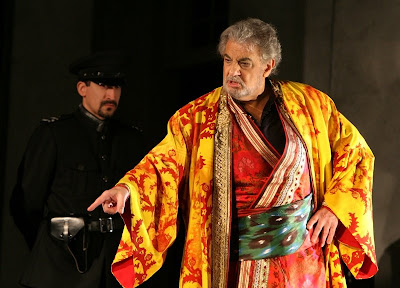Tamerlano @ WNO
 Plácido Domingo (Bajazet) in Tamerlano, Washington National Opera, 2008 (photo by Karin Cooper) |
The Ottoman emperor Bayezid I once boasted that his horse would use the Throne of St. Peter as its manger, an anecdote related by Gibbon in The History of the Decline and Fall of the Roman Empire. Bayezid's fatal battle with the Tartar emperor Timur Lenk in 1402 has been recounted numerous times. Both Christopher Marlowe (Tamburlaine, 1588) and Jean Racine (Bajazet, 1672) made the story into plays, and not long after that operas were being staged that told versions of the final downfall of the proud sultan. Stories of Bayezid's humiliation while he was Timur Lenk's prisoner -- Timur used him as a footstool, kept him caged like an animal, made his wife dance naked for his court -- and resultant suicide from despair are probably apocryphal, but they make for great drama. It is a strange twist of fate that in Italy, directly threatened by Bayezid I and the Ottomans, opera should largely depict him as a sympathetic figure.
 David Daniels (Tamerlano) and Sarah Coburn (Asteria) in Tamerlano, Washington National Opera, 2008 (photo by Karin Cooper) |
According to a preview article by Anne Midgette earlier this week, we have David Daniels to thank for it, because he suggested the opera to Domingo. Of the cast of six, Daniels was the only singer who truly felt at home in this music, comfortable with its extravagant demands for florid singing, with its embellishments. Although he is not one of my favorite countertenors, he was in excellent voice and nailed the loathsome arrogance of the title role. Only in his big aria in Act III did some threads show, at least until he had convinced conductor William Lacey to move the orchestra at the faster pace he wanted. Andronico, the more important castrato role created by Handel's bête noire Senesino, was entrusted to mezzo-soprano Patricia Bardon, who also sang with Domingo in his Madrid debut of the role. In her Washington debut, she displayed an athletic, robust voice with incisive color, with what sounded like an aborted cadenza in her first aria as the only misstep.
Anne Midgette, Domingo, a Lion in Winter in 'Tamerlano' (Washington Post, May 2) Tim Smith, Domingo delivers 'Tamerlano' (Baltimore Sun, May 2) Allan Kozinn, Amid the Baroque and the Bluster, Love Blossoms (New York Times, May 2) Dominic McHugh, Handel: Tamerlano (Musical Criticism, May 1) Idle Thoughts (Out West Arts, May 1) |
The production, directed by Chas Rader-Shieber, seemed to have been modeled on some of the minimalist stagings common for Baroque opera in Europe. The sets and costumes by David Zinn placed the story in an unspecified autocratic state, the interiors of a stark white marble Italian fascist palazzo policed by immobile Gestapo lookalikes. Tamerlano and his often unwilling ally Andronico were costumed in plain gray suits, against which only the exotic colors of Bajazet and his daughter Asteria provided any relief. Lighting by Christopher Akerlind provided a sense of the progress of time in each act, from morning brilliance to dusky evening. It was ugly, but few fascist regimes are known for their aesthetic tastes.
 Plácido Domingo (Bajazet) in Tamerlano, Washington National Opera, 2008 (photo by Karin Cooper) |
The direction of the singers was generally strong, playing the story for its drama instead of resorting to distanced irony. The only exception was the ending of the opera, which caused many in the audience to laugh as Tamerlano suddenly changed direction after Bajazet's suicide. One must blame Rader-Shieber for that stupid laughter, since by having Daniels simply sit by as Bajazet died made the transition more ridiculous than it should have been. Suddenly, he stood up and was emotionally overcome, which did not make sense. If he were listening to the death scene and moved by it as much as we in the audience, the lieto fine would ring much less false.
Handel's Tamerlano will be repeated on May 2, 4, 12, 20, and 22, in the Kennedy Center Opera House. Good luck finding a ticket.





















































1 comment:
Here in South Florida, FGO is currently reviving a production of Julius Ceasar (that's how they advertise it). The first time around they headlined Daniels; now they're giving the ad space to Cleo (of course). However, they retain two countertenors in the production.
http://www.fgo.org/07-08/production5.shtml
Post a Comment